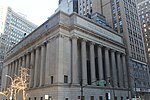Garrick Theatre (New York City)

The Garrick Theatre was a 910-seat theatre built in 1890 and located on 67 West 35th Street in Manhattan, New York City. Designed by Francis Hatch Kimball, it was commissioned by Edward Harrigan, who also managed the theatre, originally named Harrigan's Theatre, until 1895. Richard Mansfield took over from Harrigan, renaming it the Garrick. Charles Frohman assumed management from 1896 until 1915. The Shuberts bought it in 1916 and leased it to Otto Kahn, who named it Théâtre du Vieux-Colombier, after a theatre in Paris of the same name. Kahn later gave it to the Theatre Guild and it resumed the name Garrick Theatre in 1919. The Shuberts resumed management in 1925 and the theatre closed as a playhouse in 1929. After a short run of burlesque, the building was demolished in 1932.
Excerpt from the Wikipedia article Garrick Theatre (New York City) (License: CC BY-SA 3.0, Authors, Images).Garrick Theatre (New York City)
West 35th Street, New York Manhattan
Geographical coordinates (GPS) Address Nearby Places Show on map
Geographical coordinates (GPS)
| Latitude | Longitude |
|---|---|
| N 40.750361111111 ° | E -73.986738888889 ° |
Address
Hilton Garden Inn
West 35th Street 63
10001 New York, Manhattan
New York, United States
Open on Google Maps







